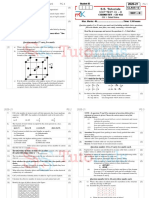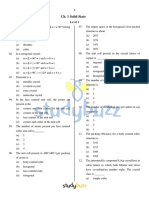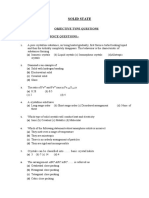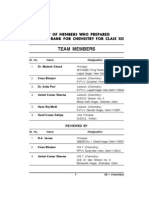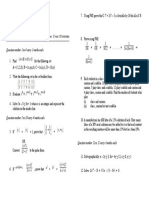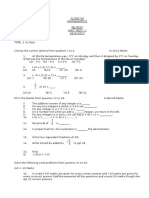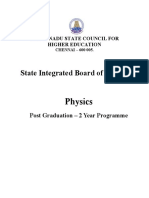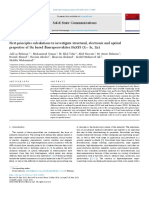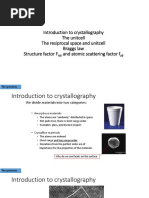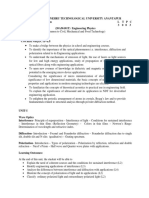Class 12 Set - B: Chemistry - CH 402
Uploaded by
SonuSharmaClass 12 Set - B: Chemistry - CH 402
Uploaded by
SonuSharmaWEBSITE: https://sstutorials.wixsite.
com/qbank PG 4 Student ID PG 1
2020-21
25. Account for the following: (3) CLASS 12
(i) Why is FeO(s) not formed in stoichiometric composition? S.S. Tutorials
(ii) ZnO turns yellow on heating. Why? UNIT TEST: 01 – B SET – B
(iii) Why is potassium chloride sometimes violet instead of pure white?
CHEMISTRY – CH 402
(iv) Why Frenkel defect not change the crystal density of AgCl crystals? CH 1: Solid States
26. Do as directed: (3) Max. Marks: 40………………………………..Time: 1.30 hours
(i) What type of defect is shown by NaCl in:
a) Stoichiometric defects and Question number 1 to 20 carry one mark each including multiple choice questions,
b) Non-stoichiometric defects fill in the blanks, true-false, case study, reasoning – assertion type.
(ii) Differentiate between a tetrahedral and octahedral hole by drawing
a diagram for both. Read the given passage and answer the questions (1 – 3) that follow:
(iii) “Stoichiometric defects are also known as intrinsic defects.” Give Solid is that form of matter which possesses rigidity and hence a definite shape
reason. and definite volume. Solids can be classified into two types: Crystalline solids and
amorphous solids. Crystalline solids have regular arrangement of particles,
definite geometric shapes, sharp melting points and definite heat of fusion. They
Question number 27 carry five marks. are anisotropic and undergo clean cleavage. On the other hand, amorphous
solids have no regular arrangement of particles, irregular shapes, melt over a
range of temperature, no definite heat of fusion. They are isotropic and undergo
27. a) What is the difference between cubic close packing (ccp) and (5) irregular cleavage. Ionic solids, molecular solids, covalent solids and metallic
hexagonal close packing? solids are the types of crystalline solids.
b) A compound MpXq has cubic close packing (ccp) arrangement of
X. Its unit cell structure is shown above. Derive the molecular 1. Solid A is very hard, electrical insulator in solid as well as molten state and (1)
formula of the compound. melts at extremely high temperature, whereas Solid B is soft, electrical
insulator and has lowest melting point. Identify and name the solid A &B?
2. Is polythene used in making polythene bags a crystalline solid or an (1)
amorphous material? Comment on its cleavage property.
3. Sodium metal is quite soft whereas sodium chloride crystals are quite hard. (1)
Why?
4. The material that softens on heating to finally flow like a liquid is (1)
(a) liquid (b) crystalline solid
(c) amorphous solid (d) polycrystalline solid
5. If ‘a’ stands for the edge lengths of the cubic systems: simple cubic, body (1)
centred cubic and face centred cubic, then the ratio of the radius of the
c) If in the above crystalline solid suppose atoms of X are arranged in spheres in these systems will be respectively
cubic close packing. Atoms of M are equally distributed between
1 √ 3 √2 1
a :√3 a :
1
a
octahedral and tetrahedral voids. If all the octahedral voids are (a) a: a: a (b)
occupied, what is the formula of the solid? 2 4 4 2 √2
1 √ 3 √2
(c) a : a: a (d) 1 a :3 a : √ 2 a
2 2 2
6. In which of the following arrangements octahedral voids are (1)
(a) hcp and bcc (c) hcp with 6 atoms at each face-centres.
(b) hcp and fcc (d) arrangement with 8 atoms at corners.
7. If Z is the number of atoms in unit cell that represents the closest packing (1)
sequence – ABCABC, the number of tetrahedral voids in the unit cell is
equal to:
Z Z
(a) Z (b) 2Z (c) (d)
2 4
8. The fraction of total volume occupied by the atoms present in a face- (1) What type of substances show this defect?
2020-21 centred unit cell is PG 2 2020-21 PG 3
(a) π / 4 (b) π / 6 (c) π /(3√ 2) (d) π /(4√ 2) NOTE : In question 19 and 20 a statement of assertion followed by a
statement of reason is given. Choose the correct answer out of the
9. Crystal system in which two axial lengths are equal is (1) following choices.
(a) Tetragonal (b) Orthorhombic (i) Assertion and reason both are correct statements and reason
(c) Monoclinic (d) Triclinic explains the assertion.
10. Among solids, the highest melting point is exhibited by (1) (ii) Assertion and reason both are correct statements but reason
(a) Covalent solids (b) Ionic solids does not explain assertion.
(c) Pseudo solids (d) Molecular solids (iii) Assertion is correct statement and reason is wrong
statement.
11. ________________ defect arises due to presence of less number of cations (1) (iv) Both assertion and reason are wrong statements.
than the ions in a crystal.
19. Assertion: Hexagonal close packing is more closely packed than cubic (1)
12. The total volume of atoms (in terms of π) in a face-centred cubic unit cell (1) close packing.
of a metal with atomic radius as ‘r’ is_________. Reason: Hexagonal close packing has a coordination number of 12
whereas cubic close packing has a coordination number of 8.
13. The two physical conditions necessary for any substance to exist in solid (1)
state are _______________ and _____________. 20. Assertion: Covalent solids are very hard and brittle. (1)
Reason: Covalent bonds are non-directional in nature.
14. State whether the given statement is True OR False. Also justify your (1)
choice. Question number 21 to 23 carry two marks each.
Amorphous solids are isotropic in in nature because like liquids they have
tendency to flow. [TRUE / FALSE] 21. Explain how vacancies are introduced in an ionic solid when a cation of (2)
higher valence is added as an impurity in it.
15. What effect does Schottky defect and Frenkel defect have on the electrical (1) 22. Based on the nature of intermolecular forces, classify the following solids. (2)
conductivity of a substance? Also name the force of attraction in each case.
16. CaCl2 will introduce Schottky defect if added to AgCl crystal. Explain. (1) Sodium sulphate, Hydrogen, Silicon carbide, Silver
23. (i) Give example of a metal each which shows the following (2)
17. Calculate the effective number of atoms in an end centred unit cell. (1) arrangement of lattice pattern in three dimensions:
18. Identify the type of defect shown in the figure: (1) a) ABCABC……
b) ABAB……….
(ii) Atoms of element P form ccp lattice and those of the element
Q occupy 1/3rd of tetrahedral voids and all octahedral voids.
Calculate the molecular formula of the compound formed by
the elements P and Q.
Question number 24 to 26 carry three marks each.
24. (i) What is the radius of sodium atom if it crystallises in bcc structure (3)
with the cell edge of 400 pm?
(ii) Examine the given defective crystal:
a) Write the term used for this type of defect?
b) What is the result when XY crystal is doped with divalent
(Z2+) impurity?
You might also like
- S.S. Tutorials 2020-21: Question Number 27 Carry Five MarksNo ratings yetS.S. Tutorials 2020-21: Question Number 27 Carry Five Marks2 pages
- S.S. Tutorials 2020-21: Question Number 24 To 26 Carry Three Marks EachNo ratings yetS.S. Tutorials 2020-21: Question Number 24 To 26 Carry Three Marks Each2 pages
- Namma Kalvi 12th Chemistry Unit 6 Study Material em 218892No ratings yetNamma Kalvi 12th Chemistry Unit 6 Study Material em 2188929 pages
- Yrk Mohan 2ND Puc Chemistry 2023 Model Questions100% (1)Yrk Mohan 2ND Puc Chemistry 2023 Model Questions5 pages
- 12 Chemistry Impq CH01 The Solid State 01 PDFNo ratings yet12 Chemistry Impq CH01 The Solid State 01 PDF7 pages
- 421873-1711527422199-Solid State CCP SHEET 1No ratings yet421873-1711527422199-Solid State CCP SHEET 111 pages
- 64c4d660ac9c100018923b99_##_Solid State : Practice Sheet || Lakshya JEE 2024No ratings yet64c4d660ac9c100018923b99_##_Solid State : Practice Sheet || Lakshya JEE 20244 pages
- 12 Chemistry Important Questions Solid State 01No ratings yet12 Chemistry Important Questions Solid State 017 pages
- Std. XII Chemistry Question Bank SolutionsNo ratings yetStd. XII Chemistry Question Bank Solutions294 pages
- Solid State: Objective Type Questions Multiple Choice QuestionsNo ratings yetSolid State: Objective Type Questions Multiple Choice Questions5 pages
- Chemistry Chapterwise Mcq Book_mht-cet (1) CopyNo ratings yetChemistry Chapterwise Mcq Book_mht-cet (1) Copy199 pages
- CLASS 9 - CHEM - CH 1 - ASSIGNMENT - 2024-25No ratings yetCLASS 9 - CHEM - CH 1 - ASSIGNMENT - 2024-252 pages
- Question Number 1 To 4 Carry 1 Marks Each.: RKSA - Group Class Xi Mathematics 2016-17No ratings yetQuestion Number 1 To 4 Carry 1 Marks Each.: RKSA - Group Class Xi Mathematics 2016-171 page
- Class Vii Mathematics Re-Test Unit Test - I 2016-2017 Maximum Marks: 50 TIME: 1 HourNo ratings yetClass Vii Mathematics Re-Test Unit Test - I 2016-2017 Maximum Marks: 50 TIME: 1 Hour2 pages
- Solid State Physics by Dr. Kamal DevlalNo ratings yetSolid State Physics by Dr. Kamal Devlal55 pages
- University of Botswana Faculty of Engineering and Technology Department of Mechanical Engineering MMB 312 - Tutorial #1No ratings yetUniversity of Botswana Faculty of Engineering and Technology Department of Mechanical Engineering MMB 312 - Tutorial #12 pages
- Fundamentals of Amorphous Solids Structure and Properties 1st Edition Zbigniew H. Stachurski - The full ebook with all chapters is available for download100% (2)Fundamentals of Amorphous Solids Structure and Properties 1st Edition Zbigniew H. Stachurski - The full ebook with all chapters is available for download44 pages
- 18 Solid State Formula Sheets Getmarks AppNo ratings yet18 Solid State Formula Sheets Getmarks App7 pages
- PDF Metallurgy For Physicists and Engineers Fundamentals Applications and Calculations 1St Edition Zainul Huda Author Ebook Full Chapter100% (3)PDF Metallurgy For Physicists and Engineers Fundamentals Applications and Calculations 1St Edition Zainul Huda Author Ebook Full Chapter40 pages
- Crystal Field and Magnetism of PR and ND Ions in Orthorhombic PerovskitesNo ratings yetCrystal Field and Magnetism of PR and ND Ions in Orthorhombic Perovskites17 pages
- ENS167 Chapter 3 Structures of Metals and CeramicsNo ratings yetENS167 Chapter 3 Structures of Metals and Ceramics101 pages
- Time: 1.30min II PUC Chemistry (34) Max. Marks: 35: Define The Term MolarityNo ratings yetTime: 1.30min II PUC Chemistry (34) Max. Marks: 35: Define The Term Molarity3 pages
- Sarvodaya.2puc - Mid-Term. IMPORTANT QUESTIONS IN CHEMISTRYNo ratings yetSarvodaya.2puc - Mid-Term. IMPORTANT QUESTIONS IN CHEMISTRY4 pages
- Eps131-Crystal Lattice and Unit Cell-BseeNo ratings yetEps131-Crystal Lattice and Unit Cell-Bsee9 pages



